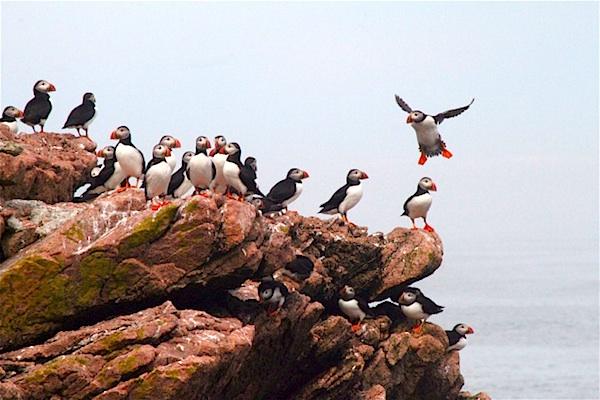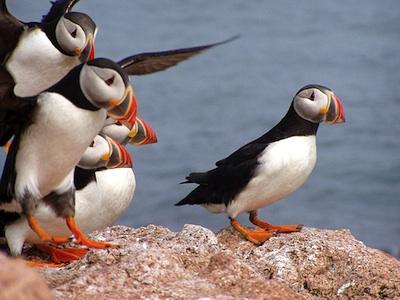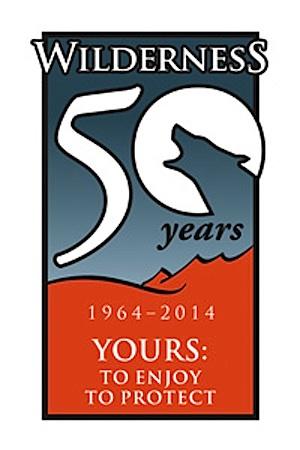
Atlantic puffins off the Maine coast/Rosie Walunas, USFWS
Editor's note: With the 50th anniversary of The Wilderness Act being marked Wednesday, it's a time for both celebration and, in some areas, continued waiting for lands to be designated. Dolores Kong and her husband, Dan Ring, looked at the state of pending wilderness in Maine and how it could help Atlantic puffins. This article originally appeared in their blog, Acadia National Park on My Mind.
People love puffins so much that visitors to Acadia National Park often ask rangers where they can see them, even though they are too far from shore to be visible.
It seems Atlantic puffins are to Maine what polar bears are to Alaska.
Yet despite the public interest in puffins, and with Sept. 3 marking the 50th Anniversary of the Wilderness Act, a bill to extend wilderness protection to some of Maine's puffin islands has languished in Congress for years.
When President Lyndon B. Johnson signed the Wilderness Act on Sept. 3, 1964, the United States became the first country in the world to define and protect wilderness. Among the wilderness definitions embodied in the act: ''¦an area where the earth and its community of life are untrammeled by man, where man himself is a visitor who does not remain.'
In Maine, from Acadia National Park to the North Woods, from Kittery to Caribou, and even along the so-called 100-Mile Wilderness of the Appalachian Trail, there's very little federally designated wilderness, a fraction of 1 percent.
Since 2005, the U.S. Fish and Wildlife Service has proposed that 13 Maine coastal islands, some near Acadia, become part of the National Wilderness Preservation System, the strongest form of federal protection. This would better preserve some puffin habitat, but Congress has yet to act.
So many visitors to Acadia National Park ask about these seabirds with the colorful beak, that the Park Service lists 'Where can I see puffins?' as the first frequently asked wildlife question. Sorry! Puffins are too far offshore to be seen from Mount Desert Island. Visitors must take a boat out to the right islands, at the right time of year, according to the National Audubon Society and the Maine Birding Trail.
And when Audubon's Project Puffin recently shared encouraging news, about a higher percentage of fledglings this summer on Maine puffin islands, nearly 800 people 'Liked' the report on the Acadia National Park Community's Facebook page.
Yet despite the public's love for puffins, Congress hasn't passed the Maine Coastal Islands Wilderness Act (H.R. 1808), reintroduced in 2013 by Rep. Michael Michaud and Rep. Chellie Pingree to help better protect the puffins and other wildlife found on the islands.

Atlantic puffins landing on rock at Maine coastal islands national wildlife refuge complex.
Although Atlantic puffins are not endangered, they are listed as threatened in Maine, the southern edge of their habitat. Puffins, which had been hunted for 300 years for their eggs, meat and feathers, usually don't breed until they are at least 5 years old, and lay only one egg a year.
Warmer ocean temperatures the last two summers affected puffins' ability to find food for chicks, but the 2013-2014 cold winter meant greater breeding success this summer. That was the update recently shared by Project Puffin, although as Acadia National Park Community noted in its Facebook posting, it's 'great news'¦at least for the time being.'
Since 1964, more than 700 wilderness areas have been designated across the country, most of them out west or in Alaska, as starkly illustrated in a map in the September issue of National Geographic magazine about the 50th Anniversary of the Wilderness Act.
Only two wilderness areas are in Maine, the Moosehorn (two units, one designated in 1970, another in 1975) and the Caribou-Speckled Mountain Wilderness (1990), totaling 18,625 acres, or a fraction of 1 percent of the state's 22.6 million acres. Generally, neither roads, vehicles (not even bicycles), nor buildings are allowed in wilderness.

Some federal protection for Atlantic puffins already exists with 48 islands part of the Maine Coastal Islands National Wildlife Refuges. But the U.S. Fish and Wildlife Service, which runs the refuges, has recommended since 2005 that extra wilderness protection be extended to 13 of those islands. The Wilderness Society and other groups have listed these islands as a priority, especially with this year marking the 50th Anniversary of the Wilderness Act. The bill to create the Maine Coastal Islands Wilderness remains stuck on Capitol Hill.
If you have a passion for puffins, whether they are visible from Acadia or not, perhaps there is no better way to mark the 50th Anniversary of the Wilderness Act than to 'Adopt' the Maine Coastal Islands National Wildlife Refuges through a Wilderness Society program; donate to Audubon's Project Puffin; participate in one of the many 50th Anniversary activities being held around the country; or contact your US Senator and Representative and urge passage of the Maine Coastal Islands Wilderness Act.



Comments
As an update to this story, we reached a press spokesman for US Rep. Michael Michaud (D-Maine), co-sponsor of the bill to extend wilderness protection to Maine puffin islands. In an e-mail, the spokesman said the Congressman remained hopeful the bill will move this year and that it is a good way to preserve the islands for generations to come. Michaud, who is running for Maine governor, will continue to advocate for the bill, the spokesman said.
The bill is currently stuck in the US House Subcommittee on Public Lands and Environmental Regulation. The panel held a hearing on the bill in July 2013
Spokespeople for US Rep. Rob Bishop (R-Utah), chair of the subcommittee, did not respond to a few e-mails seeking comment.
US Rep. Doc Hastings (R-Washington), chair of the House Committee on Natural Resources, controls what legislation moves out of panel, and when, said Michaud’s spokesman.
Spokespeople for Hastings did not respond to a few e-mails.
The press office for the other co-sponsor of the bill, US Rep. Chellie Pingree (D-Maine) also did not respond to an e-mail seeking comment.
On afternoon of Sept. 4, just heard back from Willy Ritch, senior advisor & communications director for Rep. Pingree, who said he would defer comment to Michaud's office since Michaud is main sponsor.